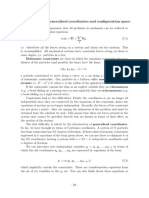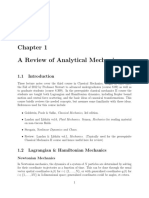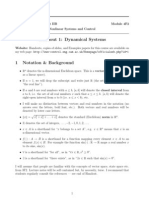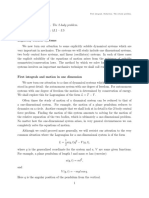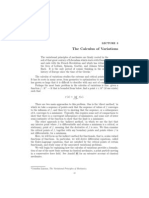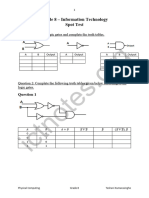Lagrangian Dynamics: 1 System Configurations and Coordinates
Lagrangian Dynamics: 1 System Configurations and Coordinates
Uploaded by
Abqori AulaCopyright:
Available Formats
Lagrangian Dynamics: 1 System Configurations and Coordinates
Lagrangian Dynamics: 1 System Configurations and Coordinates
Uploaded by
Abqori AulaOriginal Description:
Original Title
Copyright
Available Formats
Share this document
Did you find this document useful?
Is this content inappropriate?
Copyright:
Available Formats
Lagrangian Dynamics: 1 System Configurations and Coordinates
Lagrangian Dynamics: 1 System Configurations and Coordinates
Uploaded by
Abqori AulaCopyright:
Available Formats
Lagrangian dynamics
Newton examined forces. From this, he derived accelerations and such. Lagrange did something dierent.
He examined energy, by using generalized coordinates. And thats what well do in this chapter as well.
1 System congurations and coordinates
1.1 Degrees of freedom
Lets consider a particle in a three-dimensional space. We need three numbers to fully describe this
particle. We thus say that the particle has three degrees of freedom. On the other hand, a rigid body
has six degrees of freedom. (Three due to its position, and three due to its orientation.) For a general
system, the number of degrees of freedom is denoted by NDOF. We usually thus need NDOF numbers
(called coordinates) to describe the system.
1.2 System congurations
Describing the conguration of a system can be done in many ways. (We could use many kinds of
coordinate systems.) However, we want to be able to work with any description of the system. To
accomplish this, we dene generalized coordinates q
i
. The collection of all possible sets of coordinates
(q
1
, q
2
, . . . , q
n
) is called the conguration space. By the way, the formulation of dynamics problems in
terms of generalized coordinates is known as Lagrangian dynamics.
1.3 Transforming coordinates
Once a problem is described in certain generalized coordiantes, it can also be described in other coordinate
systems. For this, we use coordinate transformations, like
q
i
= q
i
(x
1
, x
2
, . . . , x
n
, t) and similarly x
i
= x
i
(q
1
, q
2
, . . . , q
n
, t). (1.1)
The latter part of the above equation is known as the inverse transformation.
2 Generalizing energy, momentum and forces
We have generalized coordinates. It would be nice if we could generalize other parameters as well. Thats
what well do in this part.
2.1 Kinetic energy
Lets examine a system with generalized coordinates q = (q
1
, q
2
, . . . , q
n
). The generalized velocities
q
i
of the system are the time derivatives of the coordinates. In other words,
q
i
=
dq
i
dt
. (2.1)
From the generalized velocities, the kinetic energy, in terms of the generalized coordinates, can be
derived. It can be shown that
T =
1
2
n
i=1
n
j=1
ij
q
i
q
j
+
n
i=1
i
q
i
+ = T
2
+T
1
+ T
0
. (2.2)
1
In this equation, T
2
is the collection of terms with the
ij
coecients, T
1
with the
i
coecients and
T
0
= . If the transformations from the generalized coordinates to the actual coordinates do not depend
on time, then T
1
= T
0
= 0. (This is the case if x
i
= x
i
(q
1
, q
2
, . . . , q
n
), or, equivalently, x
i
/t = 0 for all
i.) In this case, we call the system a natural system.
Sadly, the above relation isnt a very easy one. The coecients
ij
,
j
and depend on the system and
the way in which the generalized coordinates are dened. Finding them requires some skill and work.
2.2 The generalized momentum
The generalized momentum in q
i
direction p
i
can be derived from the kinetic energy. It is dened as
p
i
=
T
q
i
. (2.3)
When calculating this partial derivative, all other variables (including the time t) remain xed.
2.3 Generalized forces
Now lets examine generalized forces Q. To do this, we examine work. We can remember that work
is force times displacement in the corresponding direction. We thus have
W =
n
i=1
F
i
x
i
. (2.4)
By using the transformations to generalized coordinates, we can rewrite this to
W =
n
i=1
j=1
F
j
x
j
q
i
q
i
=
n
i=1
Q
i
q
i
. (2.5)
In this equation, Q
i
is the generalized force in the direction of the coordinate q
i
. It is given by
Q
i
=
n
j=1
F
j
x
j
q
i
. (2.6)
It may be important to note that the amount of work performed does not depend on changes in time.
Lets examine a force that is conservative in the real physical word. The corresponding potential function
is V . (We thus have F = V .) In this case, it can be shown that the corresponding generalized force
is also conservative. In fact, we have
Q
i
=
V
q
i
or, equivalently, Q = V. (2.7)
Note that, to use this function, we rst have to transform V . First, V was a function of the physical
coordinates. (So V = V (x
1
, x
2
, . . . , x
n
).) But, to use the above equation, V has to be a function of the
generalized coordinates. (Thus V = V (q
1
, q
2
, . . . , q
n
).)
3 The generalized equations of motion
3.1 Finding the generalized equations of motion
Newton once stated that F = mr or, equivalently, F = p. This relation doesnt always work with gener-
alized forces. This is because, in generalized coordinates, force is not the time derivative of momentum.
2
(So p = Q.) Instead, we have
p = Q+T, or, in components, p
i
= Q
i
+
T
q
i
. (3.1)
We can also recall that p
i
=
dpi
dt
=
d
dt
T
qi
. Putting things together gives
d
dt
T
q
i
T
q
i
= Q
i
. (3.2)
This very important relation is known as Lagranges Equations of Motions. (It holds for every
coordinate q
i
.)
3.2 The Lagrangian function
In some cases, we can simplify Lagranges equations of motion. Lets suppose that the force Q
i
acting
on the system is conservative. We thus have a conservative system. So there is a function V (q) such
that Q
i
= V/q
k
. If this is the case, then
d
dt
L
q
i
L
q
i
= 0, (3.3)
where L(q, q, t) = T(q, q, t) V (q) is known as the Lagrangian function.
Sometimes, however, we cant nd a potential function V (q) such that Q
i
= V/q
i
. But, we may be
able to nd a function V (q, q, t) such that
Q
i
=
d
dt
V
d q
i
V
q
i
. (3.4)
The function V (q, q, t) is then known as the generalized potential. If there is such a generalized
potential, then the system is called a Lagrangian system. And, if we again dene L(q, q, t) =
T(q, q, t) V (q, q, t), then equation (3.3) still holds.
3.3 Lagrangian systems
Energy is not always conserved in a Lagrangian system. However, there may be another quantity that is
conserved. We dene the Jacobi energy function h as
h(q, q, t) = L +
n
i=1
q
i
L
q
i
. (3.5)
It can now be shown that
dh
dt
=
L
t
. (3.6)
So, if L does not explicitly depend on the time t, then h is constant. It is thus conserved. If this is indeed
the case, then we have
h = T
2
T
0
+ V. (3.7)
For natural systems, we have T
1
= T
0
= 0 and thus h = T +V . In this case, the mechanical energy T +V
is thus conserved as well.
3
3.4 Ignorable coordinates
Lets consider a Lagrangian system with n degrees of freedom. We suppose that there are m generalized
coordinates q
nm+1
, . . . , q
n
that do not appear in the Lagrangian L. These coordinates are called inactive
or ignorable coordinates. (We will soon see why.) For these coordinates, we have L/q
i
= 0, where
n m < i n. This implies that
d
dt
L
q
i
= 0, or, equivalently,
L
q
i
= C
i
, (3.8)
where again n m < i n. The above equation is known as an integral of motion (a quantity
that stays constant during the motion). The constant C
i
is related to the momentum corresponding to
coordinate q
i
.
We use the above relation, when dening the Routhian function. The Routhian function R is dened
as
R = L +
n
i=nm+1
C
i
q
i
. (3.9)
The ignorable coordinates do not appear in the Routhian function. Instead, the Routhian function
contains the constants C
i
. By using the Routhian function, we can rewrite the equations of motion for
the nonignorable coordinates to
d
dt
R
q
i
R
q
i
= 0, (3.10)
where this time 1 i n m. We now only have n m equations of motion left. We therefore ignore
the equations of motion corresponding to the ignorable coordinates. Once the equations of motion have
been solved, the ignorable coordinates can be found using
q
i
=
R
C
i
or, equivalently, q
i
(t) =
t
t0
R
C
i
d, (3.11)
where n m < i n. By the way, we can also express the Jacobi energy function h as a function of R.
We then nd that
h = R
nm
i=1
q
i
R
q
k
. (3.12)
3.5 Steady motion
A special type of motion is steady motion. In a steady motion, all the nonignorable coordinates are
constant. We thus have q
i
= q
i
= 0 for 1 i nm. Because of this, the equations of motion reduce to
R
q
i
= 0, (3.13)
for 1 i n m. On the other hand, the ignorable coordinates have a constant velocity. We thus have
q
i
= v
i
= constant for n m < i n.
3.6 Disippative systems
Lets examine the forces Q
i
acting on a non-Lagrangian system. Part of these forces Q
lagr
i
can be derived
from a generalized potential function V (q, q, t), according to equation (3.4). However, another part can
not be derived from such a potential function.
4
Examples of forces that cant be derived from a potential are frictional forces. These forces can not be
connected to a potential, since energy is dissipated. In real (physical) coordinates, such forces are usually
described by functions like F
fr
i
= c
i
x
i
. (This relation holds for all i.) From this, we can derive that
the frictional generalized forces Q
fr
i
are given by
Q
fr
i
=
1
2
q
i
n
i=1
c
i
x
2
i
=
D
q
i
. (3.14)
The parameter D is known as Rayleighs Dissipation Function. It is dened as
D =
1
2
n
i=1
c
i
x
2
i
. (3.15)
By using this function, we can rewrite the equations of motion to
d
dt
L
q
i
L
q
i
+
D
q
i
= Q
i
. (3.16)
In this equation, Q
i
denotes the part of the force Q
i
that is not derivable from a potential function or a
dissipation function.
4 Constraints
4.1 Holonomic constraints
Systems can have certain constraints. Constraints reduce the number of degrees of freedom. Lets
examine a system normally having n degrees of freedom. If this system is given c constraints, then the
remaining number of degrees of freedom is NDOF = n c.
There are many types of constraints. So-called holonomic constraints can be written as
f(q
1
, q
2
, . . . , q
n
) = constant or f(q
1
, q
2
, . . . , q
n
, t) = constant. (4.1)
If the constraint does not depend on time (as in the rst relation), then the constraint is scleronomic.
Otherwise, it is rheonomic. We can put holonomic constraints in the so-called dierential form. To
do this, we have to use the chain rule. We then nd that
df =
f
q
1
dq
1
+
f
q
2
dq
2
+ . . . +
f
q
n
dq
n
+
f
t
dt = 0. (4.2)
4.2 Nonholonomic constraints
Some constraints can not be written in the form shown in equation (4.1). These constraints are known
as nonholonomic constraints. There are two important types of nonhomolic constraints. These are
inequalities and nonintegrable dierential expressions. Their forms are, respectively,
g(q
1
, q
2
, . . . , q
n
, t) 0 and A
1
dq
1
+A
2
dq
2
+. . . + A
n
dq
n
+A
0
dt = 0, (4.3)
where the dierential expression (the one on the right) is nonintegrable. By the way, the coecients A
i
dont have to be constant. They can depend on time. Nonholonomic constraints are usually a bit more
dicult to deal with than holonomic constraints. Luckily, they appear less frequently too.
5
4.3 Forces caused by constraints
Lets examine a system. This system has a set of J constraints that can be written as
A
j
q = A
j1
q
1
+ A
j2
q
2
+. . . + A
jn
q
n
= 0, (4.4)
where the index j is between 1 and J. Lets consider one of these constraints. This constraint demands
that the position of the system (in the conguration space) moves along a certain n1-dimensional plane.
To keep the position of the system in this plane, a reacting constraint force R
j
acts on the system.
The only eect/goal of this force is to keep the conguration of the system in the plane. It thus acts
perpendicular to the plane.
Now lets examine a movement q of the system. Due to the constraint, this movement q must be
performed in the n1-dimensional plane. Since A
j
q = 0, the vector A
j
must be perpendicular to the
plane. This implies that R
j
and A
j
have the same direction. We can thus write R
j
=
j
A
j
, where the
Lagrange multiplier
j
is (at the moment) an unknown number.
In the equations of motion, we need to take the reaction forces R
j
into account. We thus rewrite these
equations to
d
dt
T
q
i
T
q
i
= Q
i
+
J
j=1
R
ji
= Q
i
+
J
j=1
j
A
ji
. (4.5)
We now have n + J equations, being n equations of motion, and J constraint equations. We also have
n + J unknowns, being the n coordinates q
i
and the J Lagrange multipliers
j
. To nd the unknowns,
all the equations have to be solved simultaneously.
6
You might also like
- The Military Standard MIL-STD-810 ExplainedDocument4 pagesThe Military Standard MIL-STD-810 ExplainedAbqori AulaNo ratings yet
- Lag RangeDocument4 pagesLag RangeNguyễn Ngọc AnNo ratings yet
- 6 Lag Rang I An DynamicsDocument17 pages6 Lag Rang I An DynamicsTan Jia En FeliciaNo ratings yet
- First Integrals. Reduction. The 2-Body ProblemDocument19 pagesFirst Integrals. Reduction. The 2-Body ProblemShweta SridharNo ratings yet
- Lagrange HandoutDocument15 pagesLagrange HandoutShade RahmawatiNo ratings yet
- VERY VERY - Advanced Dynamics PDFDocument129 pagesVERY VERY - Advanced Dynamics PDFJohn Bird100% (1)
- Ch01 PDFDocument33 pagesCh01 PDFphooolNo ratings yet
- Where Are We Now?: F L Q LDocument20 pagesWhere Are We Now?: F L Q LgornetjNo ratings yet
- Legrangian FormalismDocument12 pagesLegrangian FormalismSreelakshmi AnilNo ratings yet
- Seminar TwoDocument3 pagesSeminar TwoibojanglesNo ratings yet
- Classical Mech TalkDocument28 pagesClassical Mech Talkayan_78No ratings yet
- Preliminaries: What You Need To Know: Classical DynamicsDocument5 pagesPreliminaries: What You Need To Know: Classical Dynamicsjamescraig229No ratings yet
- Small Oscillations. Normal Modes. ExamplesDocument13 pagesSmall Oscillations. Normal Modes. ExamplesShweta SridharNo ratings yet
- Hamiltons Principle 1 PDFDocument23 pagesHamiltons Principle 1 PDFVinaykumar YadavNo ratings yet
- Gaskin MechanicsDocument47 pagesGaskin MechanicsLia MewwNo ratings yet
- Goldstein Classical Mechanics - Chap15Document53 pagesGoldstein Classical Mechanics - Chap15ncrusaiderNo ratings yet
- Constraints, Generalised Coordinates and Configuration SpaceDocument7 pagesConstraints, Generalised Coordinates and Configuration SpaceLeo KutsNo ratings yet
- Hamilton's Principle and Symmetries: Sourendu GuptaDocument14 pagesHamilton's Principle and Symmetries: Sourendu GuptaSaikat PayraNo ratings yet
- NRQMJJ Hamiltonjacobiv1Document9 pagesNRQMJJ Hamiltonjacobiv1Mayaa KhanNo ratings yet
- Classical MechanicsDocument6 pagesClassical MechanicsSebastian Soto PerdomoNo ratings yet
- Lecture Notes For Physical Chemistry II Quantum Theory and SpectroscoptyDocument41 pagesLecture Notes For Physical Chemistry II Quantum Theory and Spectroscopty3334333No ratings yet
- The Hamiltonian MethodDocument53 pagesThe Hamiltonian Methodnope not happeningNo ratings yet
- Dynamical Systems: R.S. ThorneDocument13 pagesDynamical Systems: R.S. Thornezcapg17No ratings yet
- 5 Central Force Motion: R R R RDocument17 pages5 Central Force Motion: R R R ROmegaUserNo ratings yet
- Lagrange Housner HudsonDocument60 pagesLagrange Housner HudsonDanielMontesdeocaNo ratings yet
- D D P T: Los Alamos Electronic Archives: Physics/9909035Document131 pagesD D P T: Los Alamos Electronic Archives: Physics/9909035tau_tauNo ratings yet
- Simultaneous Diagonalization of Two Quadratic Forms and A Generalized Eigenvalue ProblemDocument7 pagesSimultaneous Diagonalization of Two Quadratic Forms and A Generalized Eigenvalue ProblemMalika BehroozrazeghNo ratings yet
- MIT8 09F14 Chapter 1Document29 pagesMIT8 09F14 Chapter 1pestaNo ratings yet
- Generalized CoordinatesDocument5 pagesGeneralized CoordinatesCosmk1ng Zero-1No ratings yet
- Noether TheoremDocument5 pagesNoether Theoremmikolaj_bugzillaNo ratings yet
- Classical Physics (PHY201) Symmetries and Conservation Laws Assignment #7Document4 pagesClassical Physics (PHY201) Symmetries and Conservation Laws Assignment #7Jagan EashwarNo ratings yet
- Structural Dynamics: Force DT MV DDocument12 pagesStructural Dynamics: Force DT MV DrajNo ratings yet
- Angular MomentumDocument6 pagesAngular Momentumprakush_prakushNo ratings yet
- Lagrangian MechanicsDocument15 pagesLagrangian Mechanicsrr1819100% (1)
- Lagrangian SummaryDocument2 pagesLagrangian SummaryShweta Sridhar100% (1)
- Bab 13 Mekanika Lagrange1Document27 pagesBab 13 Mekanika Lagrange1Front Line 7No ratings yet
- Lagrangian and Hamiltonian MechanicsDocument7 pagesLagrangian and Hamiltonian MechanicsNirmaan Shanker100% (1)
- Preliminaries: What You Need To Know: Classical DynamicsDocument5 pagesPreliminaries: What You Need To Know: Classical Dynamicsclarkalel1No ratings yet
- Bazzucchi Campolmi ZattiDocument47 pagesBazzucchi Campolmi ZattiFilippoPippoCampolmiNo ratings yet
- Chapter 07Document23 pagesChapter 07api-3728553No ratings yet
- Where Are We Now?: L X (T), X (T), T X (T), X (T), T U X (T), X (T), TDocument15 pagesWhere Are We Now?: L X (T), X (T), T X (T), X (T), T U X (T), X (T), TgornetjNo ratings yet
- uH#w:M3 EE XFD") ) H ZXVPJTL, IcSAXDNreJAXvE6dP2 FEDocument1 pageuH#w:M3 EE XFD") ) H ZXVPJTL, IcSAXDNreJAXvE6dP2 FEheaan.lasaiNo ratings yet
- Chapter 04Document36 pagesChapter 04Son TranNo ratings yet
- Hamiltonian Dynamics: I I I I I IDocument13 pagesHamiltonian Dynamics: I I I I I Ifree_progNo ratings yet
- TimerevDocument22 pagesTimerevjohann1685No ratings yet
- Handout 1Document16 pagesHandout 1Chadwick BarclayNo ratings yet
- LagrangianDocument23 pagesLagrangianrp dotgNo ratings yet
- Introduction. Configuration Space. Equations of Motion. Velocity Phase SpaceDocument11 pagesIntroduction. Configuration Space. Equations of Motion. Velocity Phase SpaceArjun Kumar SinghNo ratings yet
- 1st Integral PDFDocument19 pages1st Integral PDFAtique KhanNo ratings yet
- Work and Energy in Inertial and Non Inertial Reference FramesDocument4 pagesWork and Energy in Inertial and Non Inertial Reference FramesLivardy WufiantoNo ratings yet
- Ch01 1Document33 pagesCh01 1Sumihar SimangunsongNo ratings yet
- Symmetries and Conservation LawsDocument13 pagesSymmetries and Conservation Lawsapi-273667257No ratings yet
- The Calculus of VariationsDocument52 pagesThe Calculus of VariationsKim HsiehNo ratings yet
- Rigid BodyDocument9 pagesRigid BodyChernet TugeNo ratings yet
- Notes On Analytical MechanicsDocument58 pagesNotes On Analytical Mechanicsrounaqul2020ipadNo ratings yet
- Chap 7Document24 pagesChap 7AmmarNikNo ratings yet
- Understanding Vector Calculus: Practical Development and Solved ProblemsFrom EverandUnderstanding Vector Calculus: Practical Development and Solved ProblemsNo ratings yet
- Green's Function Estimates for Lattice Schrödinger Operators and ApplicationsFrom EverandGreen's Function Estimates for Lattice Schrödinger Operators and ApplicationsNo ratings yet
- Mechatronics Systems: About The CourseDocument2 pagesMechatronics Systems: About The CourseAbqori AulaNo ratings yet
- Assassin's Creed - ChronicleDocument27 pagesAssassin's Creed - ChronicleAbqori AulaNo ratings yet
- Photos of Microscopic LiveDocument45 pagesPhotos of Microscopic LiveAbqori AulaNo ratings yet
- RotationDocument190 pagesRotationNguyễn Khang NinhNo ratings yet
- Chapter 12. Rotational DynamicsDocument86 pagesChapter 12. Rotational DynamicsAbqori AulaNo ratings yet
- Chapter 12. Rotational DynamicsDocument86 pagesChapter 12. Rotational DynamicsAbqori AulaNo ratings yet
- Anonymous - OpIsrael Update 15 Nov 2012Document8 pagesAnonymous - OpIsrael Update 15 Nov 2012Abqori AulaNo ratings yet
- Google Earth TBX TutorialDocument9 pagesGoogle Earth TBX TutorialZainal AbidinNo ratings yet
- Simple Bash Script2Document5 pagesSimple Bash Script2Abqori AulaNo ratings yet
- Suspension SystemDocument8 pagesSuspension SystemAbqori AulaNo ratings yet
- Semester 1 Timetable: Generated On 18 September 2015Document2 pagesSemester 1 Timetable: Generated On 18 September 2015Miguel A GonzálezNo ratings yet
- MACM - Module II (Part-II)Document14 pagesMACM - Module II (Part-II)shaikfazal9392No ratings yet
- Bresenham'S Line Drawing AlgorithmDocument14 pagesBresenham'S Line Drawing AlgorithmMeherun Islam TitoNo ratings yet
- Competent Communication of JPEG2012 Over Wireless GrooveDocument4 pagesCompetent Communication of JPEG2012 Over Wireless Grooveeditor_ijarcsseNo ratings yet
- Module 4Document4 pagesModule 4alohanegraNo ratings yet
- My Research Paper On Data StructuresDocument15 pagesMy Research Paper On Data StructuresRyan Paolo SalvadorNo ratings yet
- Digital Signal Processing Lab - DR - R KumaraswamyDocument56 pagesDigital Signal Processing Lab - DR - R Kumaraswamysiap scribdNo ratings yet
- Naïve Bayes Classifier AlgorithmDocument14 pagesNaïve Bayes Classifier Algorithmshreya sarkarNo ratings yet
- Module 2Document5 pagesModule 2Sumukh KiniNo ratings yet
- 2023-Low-Complexity - Precision-Scalable - Multiply-Accumulate - Unit - Architectures - For - Deep - Neural - Network - AcceleratorsDocument5 pages2023-Low-Complexity - Precision-Scalable - Multiply-Accumulate - Unit - Architectures - For - Deep - Neural - Network - AcceleratorsSohan SaiNo ratings yet
- Divide Et ImperaDocument9 pagesDivide Et ImperaAdrian TolanNo ratings yet
- Ni 2.2.1Document29 pagesNi 2.2.1Kaushal singhNo ratings yet
- Diff n2 HL - SL Vid PDFDocument21 pagesDiff n2 HL - SL Vid PDFfayekoNo ratings yet
- Order of Complexity AnalysisDocument9 pagesOrder of Complexity AnalysisMusic LifeNo ratings yet
- Css Techmax CompressedDocument392 pagesCss Techmax CompressedAaditya ChettiarNo ratings yet
- Year 3/4 & MSC Applied/Pure Teaching Timetable Ay2023/24: Spring Term (Mon 8Th Jan - Fri 22Nd Mar)Document4 pagesYear 3/4 & MSC Applied/Pure Teaching Timetable Ay2023/24: Spring Term (Mon 8Th Jan - Fri 22Nd Mar)Herbert MohanuNo ratings yet
- OpenFoam and Incompressible FlowsDocument5 pagesOpenFoam and Incompressible FlowsOsvaldo BenitezNo ratings yet
- Tractable & Intractable Problems: - We Will Be Looking atDocument12 pagesTractable & Intractable Problems: - We Will Be Looking atSaske UchihaNo ratings yet
- HW 12Document4 pagesHW 12deweazyNo ratings yet
- GPS in Kalman FilterDocument5 pagesGPS in Kalman FilterChamil GomesNo ratings yet
- System Dynamics and Control Itü ProgramDocument3 pagesSystem Dynamics and Control Itü ProgramCeren ArpakNo ratings yet
- Logic Gate QuizDocument6 pagesLogic Gate QuizUmayangaNo ratings yet
- Coefficient of DeterminationDocument8 pagesCoefficient of DeterminationPremlata NaoremNo ratings yet
- CFDDocument18 pagesCFDPriya PatankarNo ratings yet
- RegressionDocument15 pagesRegressionSophia RusliNo ratings yet
- Spring 2023 Mth301 1 SolDocument7 pagesSpring 2023 Mth301 1 SolFatma beygNo ratings yet
- Competitive LearningDocument17 pagesCompetitive Learningrupali sakreNo ratings yet
- DSP Question BankDocument5 pagesDSP Question Bank19R21A04H8 VANKA AJAY BABUNo ratings yet
- Tools For Modeling Disease Dynamics: Gunasekaran Manogaran Vit University, VelloreDocument46 pagesTools For Modeling Disease Dynamics: Gunasekaran Manogaran Vit University, VelloreWagner FranklinNo ratings yet
















